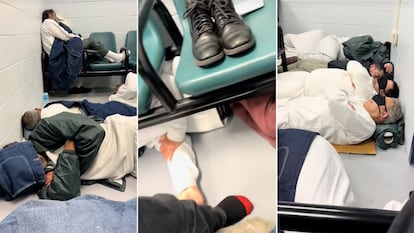‘Inhumane conditions’ and death at Miami’s Krome migrant detention center
Growing reports of overcrowding and mistreatment at Florida’s largest immigration enforcement facility have sparked protests and are yet another example of the use of cruelty as a deterrent


“We’re practically kidnapped.” “They treat us like dogs.” “This is hell on earth.” Testimonies of the conditions endured by detained migrants find their way out of the Krome Detention Center, located on the edge of Miami, where the city merges with the immense swamps of the Everglades. At Florida’s largest migrant detention facility — originally a Cold War missile base and known for its poor conditions since it began operating as a temporary prison for immigrants — no cameras or personal cell phones are allowed. Legal representatives for detainees are the only outsiders allowed in, and official communications are limited. But in recent weeks, viral videos on social media, complaints from family members, lawyers, and activists, and even a couple of deaths at the center since late January have put the spotlight on Krome. The situation is such that some detainees are requesting to be deported rather than spend more time there. It’s yet another example of the deployment of cruelty as a deterrent strategy.
Last weekend, the first protests took place on the access road to the facility, and dozens of people made clear their rejection of the “inhumane conditions” at Krome, which have recently come to light. Outrage began to grow precisely with the news of the death of Maksym Chernayak, a 44-year-old Ukrainian who was in the country thanks to the humanitarian parole program, on February 20. As that news broke, so did the death of Genry Ruiz Guillén, a 29-year-old Honduran, who had died on January 23. Both died in the custody of U.S. Immigration and Customs Enforcement (ICE) and had been detained at Krome before being transferred to a hospital where they could not be saved. Details of each case are limited — in that of Ruiz Guillén, there isn’t even an official cause of death — and family members and lawyers are trying to clarify the sequence of events that led to the loss of life to determine whether the deaths could have been prevented.
Suspicions about possible irregularities in the protocols are not unfounded. Florida immigration lawyers have known about Krome’s notorious status for years, although the current situation is clearly different. Speaking to a local television station, immigration attorney Katie Blankenship said she would never be able to erase the images of women held at Krome — which began admitting female detainees more than 20 years after an investigation into sexual abuse by guards in 2000. “Every time I walked in there, there was literally a group of women with no room to move, banging on the window, pleading, because they saw someone who wasn’t an agent. They saw that I was a lawyer and said, ‘Please help us. Please help us. Please help us.’” Blankenship adds that her clients — whom she now meets in separate rooms as the meeting rooms have become collective cells for dozens of people — are sleeping in the bathrooms: “Their faces are literally under the toilet.”
Other accounts from women collected by various local media outlets describe how they were forced to spend hours — up to 16 in some cases — with tight chains around their wrists, chests, and hips on buses outside the facilities without water, food, or access to bathrooms. The accounts, which cover different dates, concur that guards instructed them to urinate or defecate inside the buses, and that some women had no choice but to do so.

But, as things stand in 2025, the situation at Krome only sounded alarm bells when a video went viral in late March. In it, Mexican citizen Osiriss Azahael Vázquez Martínez secretly records the room where he is being held with dozens of other migrants. The images show men sleeping on the floor, on waiting room chairs, or even on a table. The subjects speak in low voices to each other, and a bright white light replacing the sun’s rays makes it impossible to tell the time of day. Then Vázquez Martínez hides under the table and speaks to the camera: “We are at the Krome Detention Center, here in Miami, Florida. We are being held captive. We are in deportation proceedings, but we have been here for more than 20 days; there are people who have been unable to communicate for more than a month. Please help us,” he says, tears beginning to well up in his eyes and his voice trembling with each word. According to the Miami Herald, which spoke with Vázquez Martínez, he was deported on March 14, three days after posting the video on TikTok.
After that video and three others posted by Vázquez Martínez were viewed millions of times, reports of the deplorable conditions at Krome began to dominate local news headlines in South Florida. In all of them, the voices of lawyers, family members, and detainees who have already been deported agree on several points: overcrowding, extreme shortages of food and liquids, lack of sufficient bathrooms, poor hygiene, increasing disease transmission, and poor and slow medical care for those who need it.
For Octavio Pérez Rodríguez, a Cuban who returned to the United States in 2022 after being deported in 2019, the situation has reached its limit. “Titi, I’m dying, I’m in pain... you can’t imagine what I’m going through,” he says in a call to his wife, Midalys López Corrales, as can be heard in a report on local Miami television. He has been detained for over a month after being arrested while attending a supposedly routine appointment with immigration agents. Now Pérez Rodríguez has officially requested deportation, as he can’t stand Krome any longer. According to several different reports, there appear to be numerous other detainees who would prefer to be expelled from the country rather than spend more time in the Florida detention center.
The overcrowding that everyone is talking about — although they can’t provide figures because they don’t have them — has been accepted but greatly minimized by ICE. According to its official figures, there are 605 people detained at Krome, although the capacity is 581. While ICE is looking for ways to increase its current detention capacity of 40,000 nationwide to 100,000, lawyers and activists estimate the real number is much higher. Some speak of double the capacity, others of up to 4,000. ICE has also stated in a generic message that it has strict medical, mental health, and hygiene standards, as well as standards for detention conditions, which include legal representation, abuse prevention, and access to interpreters.

Sign up for our weekly newsletter to get more English-language news coverage from EL PAÍS USA Edition
Tu suscripción se está usando en otro dispositivo
¿Quieres añadir otro usuario a tu suscripción?
Si continúas leyendo en este dispositivo, no se podrá leer en el otro.
FlechaTu suscripción se está usando en otro dispositivo y solo puedes acceder a EL PAÍS desde un dispositivo a la vez.
Si quieres compartir tu cuenta, cambia tu suscripción a la modalidad Premium, así podrás añadir otro usuario. Cada uno accederá con su propia cuenta de email, lo que os permitirá personalizar vuestra experiencia en EL PAÍS.
¿Tienes una suscripción de empresa? Accede aquí para contratar más cuentas.
En el caso de no saber quién está usando tu cuenta, te recomendamos cambiar tu contraseña aquí.
Si decides continuar compartiendo tu cuenta, este mensaje se mostrará en tu dispositivo y en el de la otra persona que está usando tu cuenta de forma indefinida, afectando a tu experiencia de lectura. Puedes consultar aquí los términos y condiciones de la suscripción digital.
More information
Archived In
Últimas noticias
All the effects of gentrification in one corner of Mexico’s Colonia Roma
Palestinian reporter Youmna El Sayed: ‘My family told me I had to choose between being a journalist or a mother’
The new language of the workplace: Knowing how to ask AI questions is more important than using it
Russell Tovey: ‘I was advised many times not to come out, I don’t think there was many people who’d done that — and I feel really proud that I’m one of those that did’
Most viewed
- The low-cost creative revolution: How technology is making art accessible to everyone
- Christian Louboutin: ‘Young people don’t want to be like their parents. And if their parents wear sneakers, they’re going to look for something else’
- US sanctions against jailed cartel leader ‘El Marro’ highlight Mexico’s lack of control over its prisons
- Liset Menéndez de la Prida, neuroscientist: ‘It’s not normal to constantly seek pleasure; it’s important to be bored, to be calm’
- Cartels in Mexico take a leap forward with narco-drones: ‘It is criminal groups that are leading the innovation race’










































